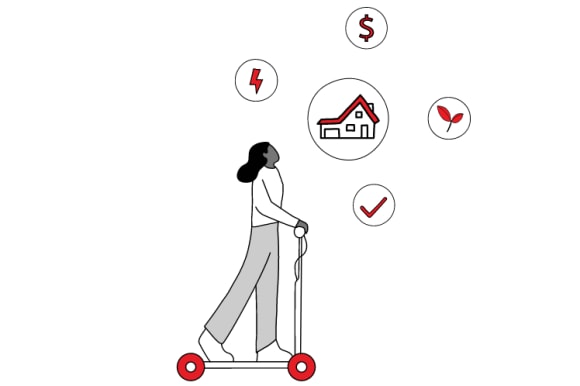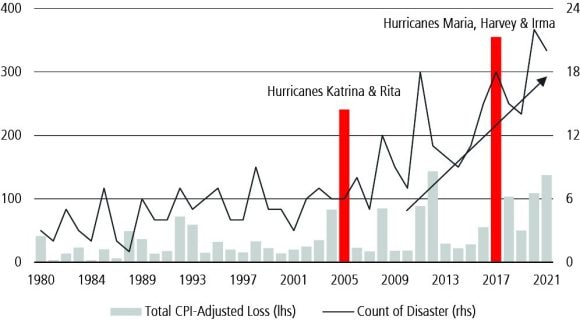The Sustainable Edge Series

Longer-term trends point to an increase in global total energy demand, which will likely be accompanied by higher electricity prices and higher carbon emissions. This has implications for investors, as well as for homeowners.
The primary residence makes up the largest source of wealth for most American households, which is why investing in a home’s energy efficiency may be important.
Residential energy efficiency ideas range from “cool roofs” to smart sensors and insulation systems. There are federal and state level consumer tax credits, including the newly adopted Inflation Reduction Act of 2022, which includes USD 9bn in incentives toward home energy efficiency.
Urbanization, population growth, and an expanding global middle class are leading to increased energy consumption. Consequently, total energy demand—and electricity demand in particular—will increase together with carbon emissions. Combined with tighter regulatory standards around emissions and tight energy supply, this means that electricity prices are likely to continue rising.
These factors create a longer-term investment thesis for companies tied to the energy efficiency theme, presenting opportunities for equity investors, while energy efficiency also has direct implications for homeowners.
The primary residence continues to make up the largest balance-sheet item, and the largest source of wealth, for most American households. In that light, understanding and preparing for longer-term trends related to sustainability, climate, and energy becomes critical.
As energy prices increase, climate risks start to materialize, and innovation picks up speed, we see many areas of crossover between residential real estate and sustainability. Investing in a home’s energy efficiency—as part of a refurbishing or upgrade project—is one of them. Others include updating cooling/heating systems or connecting to renewable energy sources. Over time, these investments may result in longer-term savings and positively impact home value.
Energy efficiency: Cost—and carbon—management
Energy efficiency: Cost—and carbon—management
Investing in energy efficiency is a relatively easy and affordable way both to reduce energy consumption and to lower CO2 emissions.
Weather patterns are becoming increasingly erratic. Nearly one in three Americans was under a heat warning in July as temperatures broke multi-decade highs. Yet, just a few months earlier, in February and March, much of the US experienced some of the coldest weather in a decade.
Extreme weather events—from heat waves to snowstorms and hurricanes—can have a devastating impact on lives and businesses. In 2021, damages from weather-related disasters totaled an estimated USD145bn, and billion-dollar weather losses have become more common (Fig. 1).
While a large part of the bill from climate-related disasters is picked up by insurance companies and taxpayers, the costs of climate change may impact household expenses as well. Case in point: A crunch in energy supply, coupled with a supply-side shock triggered by the war in Ukraine, has caused electricity prices to soar in the US. Even before the war, nominal electricity expenditure was on the rise. According to the EIA, in 2021, nominal electricity expenditure shot up 4.3%, the second largest increase in a decade. It is likely that we will see another jump in the figure for this year.
In addition to potential savings at the household level, energy efficiency efforts may have a positive impact on emission reduction as well. In the US, residential real estate accounts for one-fifth of total greenhouse gas emissions, making this a core focus area for decarbonization.
Billion-dollar weather events, by year
In USD million
Billion-dollar weather events, by year
In USD million

What does residential energy efficiency look like?
What does residential energy efficiency look like?
For homeowners, opportunities to retrofit their homes to improve energy efficiency can be integrated with home renovation plans. A few areas that can be upgraded to make the home more energy efficient include:
- Appliances and home electronics: Refrigerators and other home appliances can be responsible for up to a quarter of a household’s energy consumption, which is why buying energy efficient ones may be an investment that pays off over time;
- Insulation and air sealing, including doors and windows: The largest consumption categories, accounting for over 50% of energy use, are tied to home heating and cooling. While these can be approached separately in home design, upgrades that improve insulation may be a way to reduce the home’s energy leakage;
- “Cool roof” design: A cool roof is designed to reflect more sunlight than a traditional one, helping keep homes cool in the summer;
- Smart sensors and other temperature management systems: These help adjust the heating/cooling needs of your home;
- Water recycling systems: While not directly energy-related, given an increase in heatwaves and drought risk in many parts of the US, the employment of technology to reuse “gray water” will likely become increasingly important to home value going forward.
In deciding where to start, you can use the Home Energy Score tool created by the US Department of Energy to help estimate the cost of improving a home’s energy score and the potential savings.
Financing and timing your sustainable home renovation
Financing and timing your sustainable home renovation
Reducing greenhouse gas emissions is a stated priority for numerous US states as well as the federal government. As such, there are a variety of incentives to support household energy efficiency and refurbishing efforts. The recently passed Inflation Reduction Act (IRA) includes various federal level consumer tax credits to make homes more energy efficient, such as home appliance electrification, heat pumps, rooftop solar, electric HVAC systems, etc. Beyond nationwide incentives, states have their own incentive programs as well. For example, California, Texas, and Florida provide home weatherization assistance.
Every household should consider its own situation and eligibility in making a decision and timing the change to align to these longer-term trends. Homeowners should also consider short-term costs, whether to pay in cash or take short-term loans, and expected savings over time.

